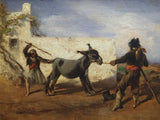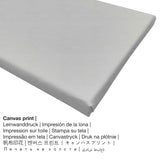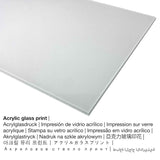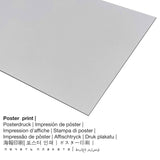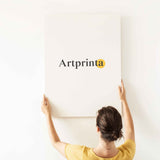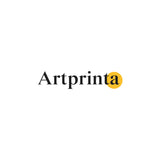Anton Romako, 1856 - The stubborn donkey - fine art print
Tax included. Shipping calculated at checkout.
The modern art artpiece The stubborn donkey was made by the historicist artist Anton Romako. The original version measures the size 26 x 34 cm - frame dimensions: 33 x 47 x 6 cm. Oil on canvas was applied by the European artist as the technique for the piece of art. Today, the artpiece forms part of the digital art collection of Belvedere in Vienna, Austria. This public domain masterpiece is included, courtesy of © Belvedere, Vienna, inventory number: 1959. : dedication Hermione Eissler, Vienna in 1918. What is more, the alignment of the digital reproduction is landscape and has a ratio of 4 : 3, which means that the length is 33% longer than the width. The painter Anton Romako was an artist from Austria, whose artistic style can primarily be classified as Historicism. The artist was born in the year 1832 in Vienna, Vienna state, Austria and died at the age of 57 in 1889.
Select your favorite item material
We offer a range of different materials and sizes for every product. Choose among the following product options now to match your preferences in size and material:
- Canvas: A UV printed canvas material mounted on a wood frame. The advantage of canvas prints is that they are relatively low in weight, which means that it is easy and straightforward to hang up your Canvas print without extra wall-mounts. A canvas print is suited for any kind of wall.
- Poster (canvas material): The poster is a printed sheet of canvas with a nice texture on the surface. It is particularly suited for placing your art replica with the help of a custom-made frame. Please bear in mind, that depending on the absolute size of the canvas poster print we add a white margin 2-6cm around the print motif to facilitate the framing with a custom frame.
- Metal (aluminium dibond print): Aluminium Dibond prints are prints on metal with a true depth effect. The Aluminium Dibond Print is the perfect start to replicas with aluminum. The white & bright sections of the original artpiece shine with a silk gloss but without any glare.
- The acrylic glass print (with real glass coating on top): A glossy print on acrylic glass, which is often labelled as a an art print on plexiglass, will turn your favorite original into décor. Beyond that, it is a viable alternative to aluminium and canvas art prints. With an acrylic glass fine art print contrasts and details become recognizeable thanks to the very fine tonal gradation of the print.
Important legal note: We try what we can in order to describe the art products as exact as possible and to exhibit them visually on the product detail pages. At the same time, the pigments of the printing material and the printing might differ slightly from the presentation on your screen. Depending on the screen settings and the quality of the surface, not all colors are printed 100% realistically. Because the fine art prints are processed and printed by hand, there may also be minor discrepancies in the exact position and the size of the motif.
Structured product details
| Article categorization: | wall art |
| Reproduction: | digital reproduction |
| Manufacturing method: | digital printing |
| Product Origin: | manufactured in Germany |
| Stock type: | on demand |
| Intended product usage: | wall art, home design |
| Orientation of the image: | landscape format |
| Image aspect ratio: | 4 : 3 length to width |
| Aspect ratio implication: | the length is 33% longer than the width |
| Available product materials: | canvas print, metal print (aluminium dibond), acrylic glass print (with real glass coating), poster print (canvas paper) |
| Canvas on stretcher frame (canvas print) size options: | 40x30cm - 16x12", 80x60cm - 31x24", 120x90cm - 47x35", 160x120cm - 63x47" |
| Acrylic glass print (with real glass coating): | 40x30cm - 16x12", 80x60cm - 31x24", 120x90cm - 47x35" |
| Poster print (canvas paper) variants: | 40x30cm - 16x12", 80x60cm - 31x24", 120x90cm - 47x35" |
| Aluminium dibond print sizes: | 40x30cm - 16x12", 80x60cm - 31x24", 120x90cm - 47x35" |
| Frame: | without frame |
Structured table of the work of art
| Title of the artpiece: | "The stubborn donkey" |
| Artwork categorization: | painting |
| Umbrella term: | modern art |
| Temporal classification: | 19th century |
| Created in the year: | 1856 |
| Artwork age: | over 160 years old |
| Medium of original artwork: | oil on canvas |
| Size of the original work of art: | 26 x 34 cm - frame dimensions: 33 x 47 x 6 cm |
| Museum / collection: | Belvedere |
| Museum location: | Vienna, Austria |
| Museum's website: | www.belvedere.at |
| License: | public domain |
| Courtesy of: | © Belvedere, Vienna, inventory number: 1959 |
| Creditline of artwork: | dedication Hermione Eissler, Vienna in 1918 |
Brief overview of the artist
| Artist name: | Anton Romako |
| Also known as: | romako a., a. romako, romako anton, Romako, Romako Anton, Anton Romako |
| Gender of the artist: | male |
| Nationality of artist: | Austrian |
| Jobs of the artist: | painter |
| Country of the artist: | Austria |
| Artist category: | modern artist |
| Art styles: | Historicism |
| Lifespan: | 57 years |
| Birth year: | 1832 |
| Place of birth: | Vienna, Vienna state, Austria |
| Year of death: | 1889 |
| Place of death: | Vienna, Vienna state, Austria |
© Copyright - Artprinta (www.artprinta.com)
Original artwork description by Belvedere website (© - by Belvedere - Belvedere)
The oil painting The stubborn donkey Anton Romako was probably in 1856 during a trip to Spain by the artist and is considered the earliest surviving genre painting in his oeuvre. The contrast, saturated colors of humorous scene corresponds to the intense light of the South. The loose and sketchy brushwork acting like about works by Francisco de Goya or El Greco remember and is probably due Romako encounter with original works of Spanish painting tradition. 1860 gained Romako in Rome primarily oriented on the art market landscape views, genre paintings and portraits large financial and social recognition. After a failed marriage to the artist in 1875 returned to Vienna, where his style but not met the prevailing taste. With his increasingly bizarre and excessive design language and the emphasis on psychological moments he took elements of early expressionism anticipated. lonely in his later years and impoverished, was Romako an outsider among the historicist painters that should be rediscovered by future generations as an important reference point. [Kerstin Krenn, in: Agnes Husslein, Severin Dünser, Luisa Ziaja (ed.), Flirting with Strangers. Encounters with works from the collection, Vienna 2015, p 106.]

